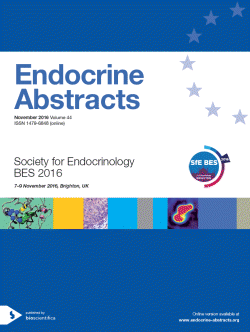
Society for Endocrinology BES 2016
Brighton,
UK
07 Nov 2016 - 09 Nov 2016

Poster Presentations
Neoplasia, cancer and late effects
ea0044p120 | Neoplasia, cancer and late effects | SFEBES2016
Multiple endocrine neoplasia type 1: ‘Are screening guidelines appropriate?’ The importance of histology and correlation of clinical signs
Redford Christopher , Vaidya Bijay
ea0044p121 | Neoplasia, cancer and late effects | SFEBES2016
Psychosocial impact of multiple endocrine neoplasia disorders
ea0044p122 | Neoplasia, cancer and late effects | SFEBES2016
Investigation of the effects and interactions of a human neuroendocrine tumour (NET) cell binding peptide
Stevenson Mark , Lines Kate , Thomas Benjamin , Thakker Rajesh
ea0044p123 | Neoplasia, cancer and late effects | SFEBES2016
MicroRNA miR-3156-5p is down-regulated in serum of Multiple Endocrine neoplasia type 1 patients, and regulates expression of mortality factor 4-like protein 2 (MORF4L2)
Lines Kate E , Stokes Victoria , Grozinsky-Glassberg Simona , Yates Christopher J , Thakker Rajesh V
ea0044p124 | Neoplasia, cancer and late effects | SFEBES2016
The prolactin receptor variant, Asn492Ile, results in activation of the Akt signalling pathway, and is found more frequently in patients with prolactinomas
Gorvin Caroline , Newey Paul , Stokes Victoria , Rogers Angela , Ntali Georgia , Lees Peter , Karavitaki Niki , Grossman Ashley , Thakker Rajesh
ea0044p125 | Neoplasia, cancer and late effects | SFEBES2016
Multiple endocrine neoplasia type 1 (MEN1) in identical twins, with different MEN1 tumours, is due to a deletion of the MEN1 5′ untranslated region (UTR)
Kooblall Kreepa , Cranston Treena , Lines Kate , Stevenson Mark , Rogers Angela , Grozinsky-Glasberg Simona , Flanagan Daniel , Thakker Rajesh
ea0044p126 | Neoplasia, cancer and late effects | SFEBES2016
Radiological surveillance in multiple endocrine neoplasia type 1: A double edged sword?
Casey Ruth , Saunders Debbie , Challis Ben , Pitfield Deborah , Cheow Heok , Shaw Ashley , Simpson Helen
ea0044p127 | Neoplasia, cancer and late effects | SFEBES2016
A review of the diagnostic sensitivity of plasma metanephrine testing in patients with SDH gene mutations
Abraham Shalin , Casey Ruth , Pitfield Deborah , Challis Ben , Simpson Helen
ea0044p128 | Neoplasia, cancer and late effects | SFEBES2016
Timing and outcome of surgery for primary hyperparathyroidism in MEN1
Joshi Mamta , McGowan Barbara , Hubbard Johnathan , Powrie Jake , Breen Louise , Jacques Audrey , Izatt Louise , Carroll Paul
ea0044p129 | Neoplasia, cancer and late effects | SFEBES2016
Low vitamin D is associated with increased bladder cancer risk; a systematic review and evidence of a potential mechanism
Bland Rosemary , Chivu Corina , Jefferson Kieran , MacDonald Donald , Iqbal Gulnaz , Dunn Janet
ea0044p130 | Neoplasia, cancer and late effects | SFEBES2016
Diagnostic performance of adrenal imaging in a high risk population for adrenal malignancy
Delivanis Danae , Nathan Mark , Atwell Thomas , Eiken Patrick , Schmit Grant , Natt Neena , Erickson Dana , Maraka Spyridoula , Young William , Bancos Irina
ea0044p131 | Neoplasia, cancer and late effects | SFEBES2016
Metformin alters an anti-proliferative effect of Mitotane in a human adrenocortical cancer (H295R) cell line: preliminary results
Dworakowska Dorota , Szyszka Paulina , Weitsman Gregory , Diaz-Cano Salvador , Korbonits Marta , Grossman Ashley , Bornstein Stefan , Ng Tony
ea0044p132 | Neoplasia, cancer and late effects | SFEBES2016
Sparsely granulated somatotroph adenomas display aspects of epithelial-mesenchymal transition
Dix Kathryn , Grossman Ashley , Ansorge Olaf , Larkin Sarah
ea0044p133 | Neoplasia, cancer and late effects | SFEBES2016
Adverse fibrin network profile in survivors of brain tumours with established hormonal deficiencies: A potential mechanism for increased vascular risk
Kyriakakis Nikolaos , Kumar Satish S , Oxley Natalie , Phoenix Fladia , Lynch Julie , Ajjan Ramzi , Murray Robert D
ea0044p134 | Neoplasia, cancer and late effects | SFEBES2016
Somatastatin analogue tolerability testing in the management of neuro endocrine tumours (NETs), a single centre review of practice
Tadman Michael , Charlton Philip , Grossman Ashley
ea0044p135 | Neoplasia, cancer and late effects | SFEBES2016
The effect of peptide receptor radionuclide therapy (PRRT) on symptoms and tumour burden in patients with metastatic neuroendocrine tumour (NET)
Abraham Stalin , Casey Ruth , Challis Ben , Pitfield Deborah , Whitley S , Shaw Ashley , Heard Sarah , Saad Zia , Buscombe John , Simpson Helen
ea0044p136 | Neoplasia, cancer and late effects | SFEBES2016
The role of primary cilia in the molecular pathogenesis of phaeochromocytoma
O'Toole Sam , Srirangalingam Umasuthan , Drake William , Chapple Paul
ea0044p137 | Neoplasia, cancer and late effects | SFEBES2016
The effects of proton pump inhibitor therapy on neuroendocrine tumour biomarkers
Constantinou Christoforos , Hill Neil , Bloom Steve , Murphy Kevin , Bech Paul



